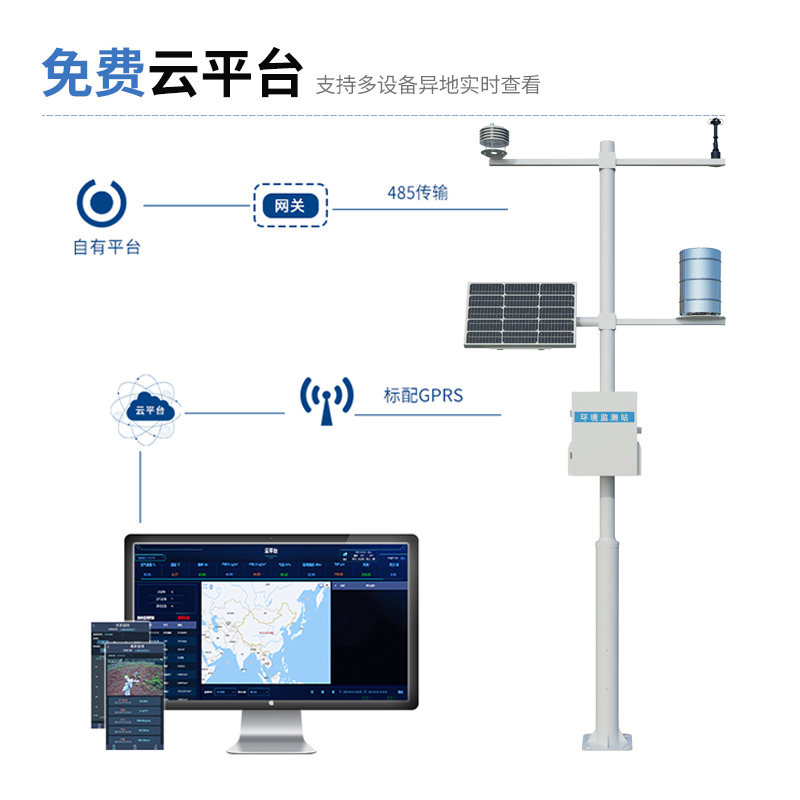Tianyi Sensor IOT Technology Co., Ltd
Sales Manager:Ms. Emily Wang
Cel,Whatsapp,Wechat:+86 15898932201
Email:info@fengtutec.com
Add:No. 155 Optoelectronic Industry Accelerator, Gaoxin District, Weifang, Shandong, China

Sales Manager:Ms. Emily Wang
Cel,Whatsapp,Wechat:+86 15898932201
Email:info@fengtutec.com
Add:No. 155 Optoelectronic Industry Accelerator, Gaoxin District, Weifang, Shandong, China
time:2025-08-05 08:55:47 source:Weather Station viewed:110 time
Please note that this is a basic meteorological instrument capable of monitoring only wind speed, wind direction, air temperature and humidity, and air pressure.
When equipped with sensors for dust concentration, harmful gases (such as sulfur dioxide, nitrogen oxides), PM2.5, PM10, etc., it becomes an environmental meteorological instrument. It can monitor air pollution in real-time, providing data for urban environmental governance and residents' health protection.
When configured with sensors for visibility, precipitation amount, precipitation type, road surface temperature, icing conditions, etc., it turns into a traffic meteorological instrument. It can timely reflect the impact of weather on roads, airports, and waterways, ensuring the safety and smoothness of transportation.
When fitted with sensors for ultraviolet intensity, negative ion concentration, comfort index, etc., it becomes a tourism meteorological instrument. It can provide thoughtful meteorological references for scenic spot management and tourists' travel, helping people better plan their travel itineraries.
When additional components like a fiberglass louver box (containing dry and wet bulb thermometers), a sunshine recorder, and enclosures are added, it becomes a campus meteorological instrument. It ensures the safety of students' outdoor activities and provides tools for campus environmental management and teaching practice.
When its vertical pole is replaced with a triangular bracket, and it is equipped with a lightweight data storage module, a low-power battery, and a quick calibration function, it becomes a portable meteorological instrument. It is convenient for outdoor workers to obtain meteorological data anytime and anywhere, suitable for scenarios such as field investigations and emergency rescue.
When configured with sensors for total solar radiation, photovoltaic module temperature, etc., it becomes a photovoltaic meteorological instrument. It can provide the necessary meteorological parameters for the efficiency evaluation, power generation prediction, and equipment maintenance of photovoltaic power stations.
It can be seen from the above that the core of configuring a meteorological instrument lies in accordance with specific application scenarios and monitoring needs. The basic model provides monitoring of core meteorological elements such as wind speed, wind direction, air temperature and humidity, and air pressure. For different fields, it only needs to add specific sensors or functional modules in a targeted manner - for example, adding pollutant monitoring sensors when focusing on environmental quality, increasing road surface and visibility monitoring functions when serving transportation, and strengthening microclimate and noise monitoring when adapting to campus scenarios. Through this "basic core + scenario-based expansion" model, meteorological instruments can accurately meet the monitoring needs of various fields such as environment, transportation, tourism, agriculture, and campus.

Although traditional mechanical wind speed and direction meters have, to some extent, met basic requirements, they have limitations in terms of accuracy, response speed, and reliability. With the advancement of technology, the 3D Ultrasonic Anemometer based on the time - difference method has been d...
A Water Quality Monitoring Buoy is an on-site water quality testing device installed in water areas such as rivers, lakes, reservoirs, and coastal waters. It is mainly used in fields like the implementation of the river chief system and the construction of sponge cities. It can conduct continuous an...
A handheld weather meter is a portable, hand-operated meteorological monitoring device capable of real-time measuring and recording multiple meteorological parameters. These devices integrate various high-precision sensors, suitable for field research, emergency monitoring, mobile observation, and o...
In today's society, with the acceleration of the processes of industrialization and urbanization, air quality issues have received increasing attention from people. There is a wide variety of pollutants in the air. Among them, the "four gases" (carbon monoxide, sulfur dioxide, nitrogen...